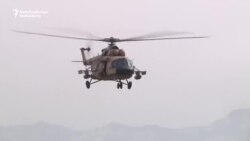LASHKAR GAH, Afghanistan -- Captain Samir, an Afghan Army helicopter pilot in Helmand, is a busy man these days. Most of the time, he wears a black helicopter helmet in the scorching desert heat of Afghanistan’s southern Helmand Province.
Samir’s typical workday consists of flying his aging Russian Mi-17 over the nearly 60,000 square kilometers of Helmand, where small army outposts scattered across its stony desert plains and crowded farming villages are frequently attacked by the Taliban. Some have remained besieged for months.
On this blazing hot day in June, his mission is to carry a shipment of arms, ammunition, and food supplies to a remote army base in Sangin district -- one of the many active front lines in Helmand, which borders Pakistan and is close to Iran.
“We fly five to seven hours a day. Sometimes, we fly even longer,” Samir said of a job that keeps him in constant danger of being shot down by the Taliban. “This is because there are some besieged outposts that can only be supplied by helicopter.”
Helmand, which comprises one-tenth of Afghanistan, has been testing the country’s fragile air force. The army’s recent success in improving battlefield surveillance and combat support underscores the vital role of the air force, which has prompted many officials and experts to request additional modern aircraft. Kabul’s NATO allies are expected to announce major multi-year funding commitments for Afghan security forces next month.
Abdul Rahman Sarjang, a former security chief in Helmand, says airpower plays a crucial role in dominating the battlefields of mountainous Afghanistan.
“Eighty percent of the battle can be won by the air force. We are mostly unable to immediately supply or support our outposts when they are attacked,” he told Radio Free Afghanistan. “When we have enough aircraft, we can protect our borders and support our troops on the battlefield.”
Nearly 32,000 Afghan Army and police soldiers in Helmand now rely on Mi-25 attack helicopters for combat support, Mi-17s for supplies and airlift, and small drones for aerial surveillance. The subsonic A-29 Super Tucano aircraft have yet to play a role in counterinsurgency or close air support capabilities since the United States donated them to the Afghan Air Force in April.
Lieutenant General Moeen Faqir, head of the Afghan Army’s 215th Maiwand Corps in Helmand, is impressed by the U.S. drones. He says his troop’s intelligence capacities have improved significantly since they began operating the 10 small unmanned ScanEagle aircraft.
Faqir says the drones are helpful for verifying information from human and signal intelligence, and that his forces can now scan areas as large as 50 kilometers to target insurgents or preempt their attacks.
“Earlier, I was dependent on reports from our outposts,” he said. “Now, I can check their information about impending or ongoing attacks by flying a drone over.”
Raz Mohammad, a tribal leader in Helmand’s Khan-e Nashin district, however, finds the Afghan Army’s modest air warfare capabilities lacking.
Mohammad says that after spending years observing insurgents fight government forces in his home district, he is convinced that surveillance drones alone cannot counter insurgents who live and hide out among civilians. For years, Khan-e Nashin has been contested by government forces and the Taliban.
“The Taliban typically avoid trench warfare. They are always on the move,” he told Radio Free Afghanistan. “We need aircraft that can destroy the enemy once they are spotted.”
Another Helmand tribal leader, Abdul Baseer, however, is not convinced. He says airpower should only be used if Afghanistan goes to war with another country.
“I think consultations for reconciliation and pressuring insurgents through their tribes will have a much better, long-lasting impact toward restoring peace,” he said.
Tucked under camouflage nets at the Afghan Army’s sprawling Helmand headquarters in Lashkar Gah are two Mi-25 attack helicopters. These war machines have been a constant feature on Helmand’s battlefield since they were donated by India in late January.
Most recently, they provided vital air support to the Afghan forces in clearing the road to the strategic district of Sangin, an important Helmand crossroad north of Lashkar Gah.
Abdullah Samadi, a former Afghan military officer, says the Afghan forces will need robust airpower to regain territory lost to the Taliban. Over the past year, the insurgents have overrun or contested 11 out of Helmand’s 15 districts. The Taliban have now virtually besieged Lashkar Gah in central Helmand.
“We share a 160-kilometer border with Pakistan, and we have active fronts in every district. This makes Helmand a very big battlefield,” he said. “We need to be able to constantly dominate this battle space.”
Tens of thousands of NATO troops served in Helmand following the 2001 demise of the Taliban regime. Their superior airpower prevented the rebels from making a major comeback.
The departure of NATO troops in late 2014, however, exposed the vulnerabilities of the Afghan forces, who subsequently lost considerable territory to the Taliban. Afghan officials and military specialists now want more aircraft to make up for their weaknesses.
“We really need a lot more aircraft than we currently have,” Samadi noted.
Abubakar Siddique wrote this story based on Mohammad Ilyas Dayee's reporting from Lashkar Gah, Helmand.









